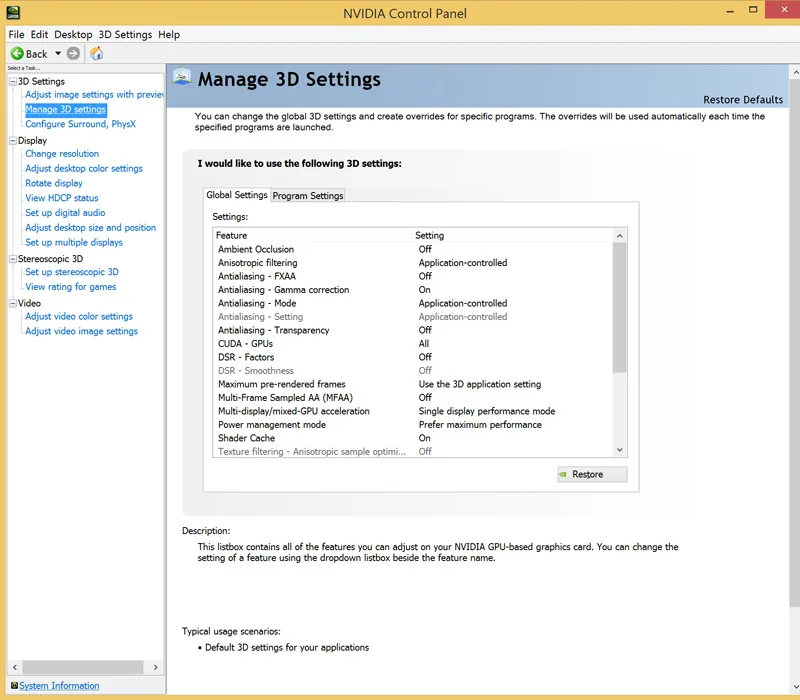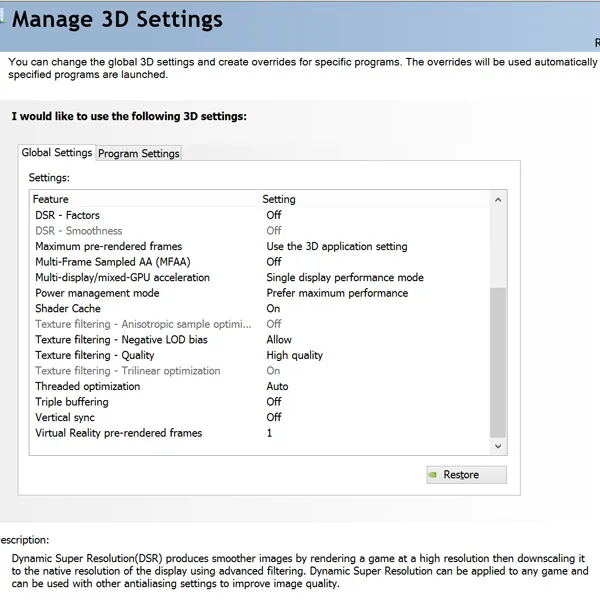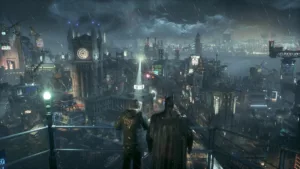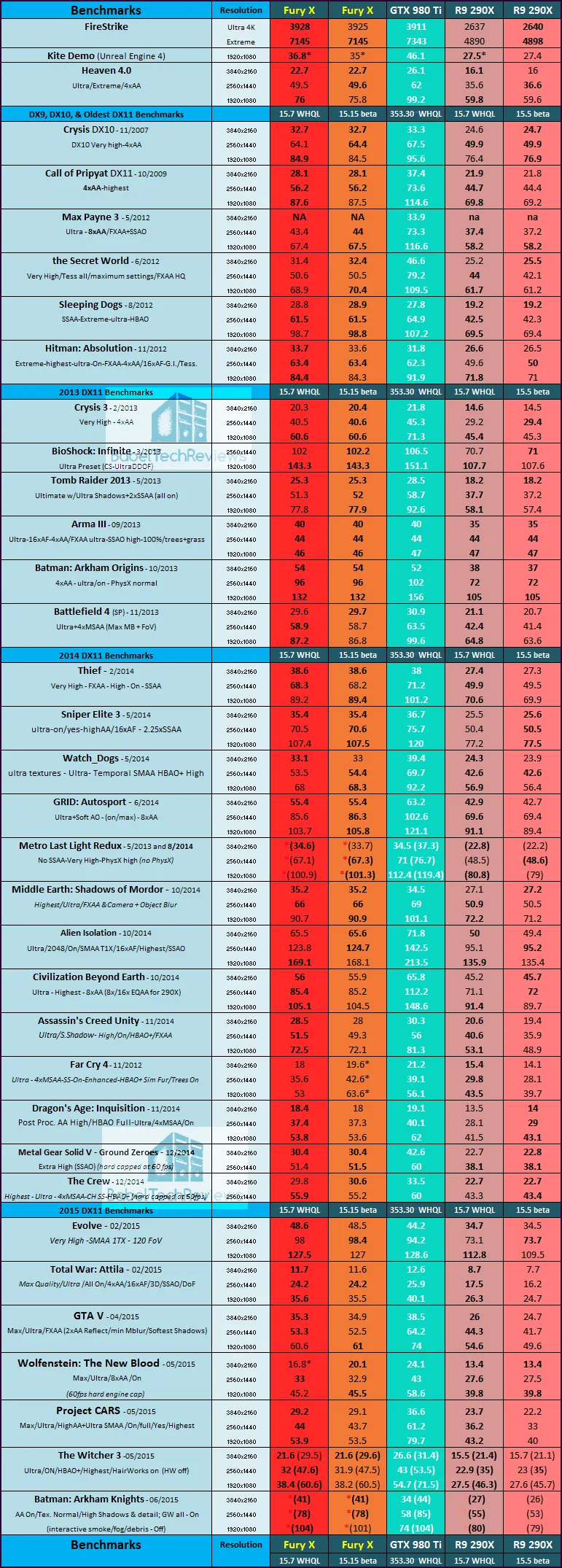As part of a regular feature for BabelTechReviews, this driver analysis will compare the performance of 32 PC games using the new WHQL Catalyst 15.7 driver which was released this past week, with the Fury X Catalyst 15.15b launch drivers, and versus the 15.5 Beta Catalyst driver that we last tested the R9 290X with. We will also give the reference GTX 980 Ti results using its very latest WHQL 353.30 drivers for another direct comparison with the Fury X.
This driver performance analysis features AMD’s new top single-GPU flagship Fury X, and AMD’s former flagship Radeon R9 290X, although we plan to regularly test lesser cards also for upcoming evaluations. We want to at least document the performance changes of this important WHQL driver set as it finally brings together a unified driver for Fury, 200 and 300 series.
 We are going to give you the performance results of the Fury X and the R9 290X at 1920×1080, 2560×1440, and at 3840×2160, using 32 games and 3 synthetics tests including the “Kite Demo” on Unreal Engine 4. This driver performance evaluation will compare the performance changes since AMD’s older 15.5 beta driver set, the Fury launch drivers, and the new WHQL 15.7 driver.
We are going to give you the performance results of the Fury X and the R9 290X at 1920×1080, 2560×1440, and at 3840×2160, using 32 games and 3 synthetics tests including the “Kite Demo” on Unreal Engine 4. This driver performance evaluation will compare the performance changes since AMD’s older 15.5 beta driver set, the Fury launch drivers, and the new WHQL 15.7 driver.
Our testing platform is Windows 8.1 64-bit, using an Intel Core i7-4790K which turbos all cores to 4.4GHz, an ASUS Z97E motherboard, and 16GB of Kingston “Beast” HyperX RAM at 2133MHz. The settings and hardware are identical except for the drivers being tested.
At R9 280X and above, we test at higher settings and at higher resolutions generally than we test midrange and lower-end cards. All of our games are now tested at three resolutions at 60Hz: 3840×2160, 2560×1440, and 1920×1080, and we use DX11 whenever possible with a very strong emphasis on the latest DX11 games. We no longer benchmark at 2560×1600, but instead use the more popular 2560×1440 resolution.
Several games have had updates which have changed their settings. Shadows of Mordor has patched in FXAA and Camera + Object Blur which is more demanding than previously and we are now testing with the highest settings available, beyond Ultra. GTA V has had multiple patches, and the Witcher 3 is on its sixth patch with a seventh patch pending. We are careful to test our drivers using the same game patch versions. We also test GameWorks features On versus Off in the Witcher 3 and also in Batman: Arkham Knight.
Let’s get right to the test configuration, to the driver release notes, and then to our results.
Test Configuration
Test Configuration – Hardware
- Intel Core i7-4790K (reference 4.0GHz, HyperThreading and Turbo boost is on to 4.4GHz; DX11 CPU graphics), supplied by Intel.
- ASUS Z97-E motherboard (Intel Z97 chipset, latest BIOS, PCOe 3.0 specification, CrossFire/SLI 8x+8x)
- Kingston 16 GB HyperX Beast DDR3 RAM (2×8 GB, dual-channel at 2133MHz, supplied by Kingston)
- Sapphire Fury X, 4GB HBM, reference clocks
- VisionTek R9 290X, 4GB, stock reference (non-throttling, fan allowed to spin to 100%) Uber clocks.
- GeForce GTX 980 Ti, 6GB reference clocks, supplied by Nvidia
- Two 2TB Toshiba 7200 rpm HDDs
- EVGA 1000G 1000W power supply unit
- Cooler Master 2.0 Seidon240 CPU water cooler, supplied by Cooler Master
- Onboard Realtek Audio
- Genius SP-D150 speakers, supplied by Genius
- Thermaltake Overseer RX-I full tower case, supplied by Thermaltake
- ASUS 12X Blu-ray writer
- Monoprice Crystal Pro 4K
Test Configuration – Software
- Nvidia GeForce 353.30 WHQL drivers for the reference GTX 980 Ti. High Quality, prefer maximum performance, single display, use application settings except for Vsync, off.
- AMD WHQL 15.7 for the Fury X and for the 290X. Catalyst 15.15b (15.15.1004) for Fury X and 15.5 Beta for 290X (15.6 Beta used for Batman: AK, Kite Demo, and for the Witcher 3). High Quality, all optimizations off, use application settings except for Vsync, off.
- AA enabled as noted in games; all in-game settings are specified with 16xAF always applied; 16xAF forced in control panels for Crysis.
- All results show average, minimum and maximum frame rates except as noted.
- Highest quality sound (stereo) used in all games.
- Windows 8.1 64, all DX10 titles were run under DX10 render paths; DX11 titles under DX11 render paths. Latest DirectX
- All games are patched to their very latest versions at the time of publication.
Here are the settings we always use in AMD’s Catalyst Control Center for our default benching.
Here is Nvidia’s Control Panel and the settings that we use:

The 32 Game benchmarks & 3 synthetic tests
- Synthetic
- Firestrike – Basic & Extreme
- Heaven 4.0
- Kite Demo, Unreal Engine 4
-
DX10
- Crysis
-
DX11
- STALKER, Call of Pripyat
- Max Payne 3
- the Secret World
- Sleeping Dogs
- Hitman: Absolution
- Tomb Raider: 2013
- Crysis 3
- BioShock: Infinite
- Metro: Last Light Redux (2014) (including PhysX on vs off)
- Battlefield 4
- ArmA 3
- Batman: Arkham Origins
- Thief
- Sniper Elite 3
- Watch_Dogs
- GRID: Autosport
- Middle Earth: Shadows of Mordor
- Alien Isolation
- Assassin’s Creed Unity
- Civilization Beyond Earth
- Far Cry 4
- Dragon’s Age: Inquisition
- Metal Gear Solid V: Ground Zeroes
- The Crew
- Evolve
- Total War: Attila
- Wolfenstein: The Old Blood
- Grand Theft Auto V
- ProjectCARS
- the Witcher 3 (including HairWorks, On vs Off)
- Batman: Arkham Knight
 This is the last time that we will use Batman: Arkham Origins as a benchmark. In its place, we will benchmark Batman: Arkham Knight since it is the latest game in the series.
This is the last time that we will use Batman: Arkham Origins as a benchmark. In its place, we will benchmark Batman: Arkham Knight since it is the latest game in the series.
If you missed the changes with the older drivers, look at AMD’s release highlights regarding the Catalyst 15.5B driver which can be found in our comparison of Catalyst 15.4B with 15.5B.
Release Notes Highlights for Catalyst 15.5 Beta
The release notes and download links for Catalyst 15.7 WHQL drivers can be found here for Windows 8.1. Unlike the usual short notes, these are more detailed. The new WHQL drivers promise some improvements for 200 series in specific games, new and improved CrossFire profiles, and they bring new features worth checking out.
- Virtual Super Resolution (VSR)
- Frame Rate Target Control™ (FRTC)
- Performance Optimizations versus AMD Catalyst™ Omega
- AMD FreeSync™ and AMD CrossFire™ Support
- AMD CrossFire™ Profile Enhancements …
Let’s head to the chart to compare the driver progress from the Fury X launch drivers and 15.5 Beta drivers for the 290X, to the new WHQL 15.7 driver since we tested them the last time.
The Summary Chart
Here is the summary chart of 32 games and 3 synthetic tests. The highest settings are always chosen and it is DX11 when there is a choice; DX10 is picked above DX9, and the settings are ultra or maxed. Specific settings are listed on the Main Performance chart. We have added the “Kite Demo” on Unreal Engine 4 using the default settings at 1920×1080 as measured by Fraps.
The benches are run at 1920×1080, 2560×1440, and 3840×2160. All results, except for Firestrike, show average framerates and higher is always better. In-game settings are fully maxed out and they are identically high or ultra across all platforms. “NA” means the game would not run at the settings chosen, and an *asterisk means that there were issues with running the benchmark, usually visual artifacting.
 We note only very few performance improvements of Fury X with AMD’s new Catalyst 15.7 WHQL driver over the slightly older launch 15.15 drivers in only a few games. Generally, the differences are just incremental benchmarking “noise”, and well within the benching margin of error. However, Assassin’s Creed: Unity evidently got a decent performance boost at our three resolutions, although most games were mixed, with small improvements perhaps at only one or two resolutions.
We note only very few performance improvements of Fury X with AMD’s new Catalyst 15.7 WHQL driver over the slightly older launch 15.15 drivers in only a few games. Generally, the differences are just incremental benchmarking “noise”, and well within the benching margin of error. However, Assassin’s Creed: Unity evidently got a decent performance boost at our three resolutions, although most games were mixed, with small improvements perhaps at only one or two resolutions.
We are not 100% sure of our Fury X Far Cry 4 results since the 15.15b launch drivers were a mess visually while 15.7 appears to have cleared up the artifacting, but the performance has significantly dropped. Although we have verified the game files, we are going to reinstall the game and will update BTR Community with our Far Cry 4 results later this week.
Batman: Arkham Knights and the Witcher 3 use 15.6B results instead of 15.5B for the 290X to compare with the new WHQL drivers, as they brought stability and performance, and these drivers were also used in our Fury X versus GTX 980 Ti review.
We do see solid performance gains with the 290X that may bring it very close to 390X performance, since the older 200 series was tested with older drivers while the new 300 series evidently got new drivers for their launch. Some of these 290X gains are very impressive in some of the newer games as with Far Cry 4, even considering that the last WHQL Catalyst drivers were released last year.
Conclusion:
 So far, we would definitely recommend upgrading to the latest Catalyst 15.7 WHQL driver because there are generally advantages that are sometimes significant, and no large performance-impacting negatives that we have encountered. Catalyst 15.7 brings new features to Radeons that are really worth checking out.
So far, we would definitely recommend upgrading to the latest Catalyst 15.7 WHQL driver because there are generally advantages that are sometimes significant, and no large performance-impacting negatives that we have encountered. Catalyst 15.7 brings new features to Radeons that are really worth checking out.
Catalyst WHQL 15.7 is also the driver to use for the latest really fun games that we are playing including, GTA V, Wolfenstein: The Old Blood, ProjectCARS, the Witcher 3, and Batman:Arkham Knight.
Stay tuned, next up we are benching for a new evaluation covering SLI scaling with a pair of GTX 980 Tis.
Happy gaming!
